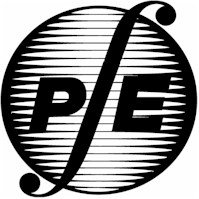Idaho Society of Professional Engineers
Friday Update - 02/20/04
WELCOME NEW MEMBERS!
Mark Forbord/Eagle Engineering
UPCOMING EVENTS:
● ISPE Southeast Chapter MATHCOUNTS Competition -
Pocatello - February 21, 2004
● ISPE Southwest Chapter MATHCOUNTS
Competition - Boise - February 21, 2004
● National Engineers Week, February 22 -
28, 2004
● Future City Competition Press Conference,
February 23, 2004, 4:00pm, RM 110 – Engineering Technology Building - Boise
State University – College of Engineering
● ISPE Magic Valley Chapter MATHCOUNTS
Competition - February 24, 2004
● Boise State University College of
Engineering Open House, Thursday, February 26, 2004, 5:00-7:00pm
● ISPE State MATHCOUNTS Competition - Boise
- March 6, 2004
● Continuing Education Seminar, Design of
Waste Containment and Closure Systems, BSU, March 24, 2004, For additional
information: Call Joseph Sener, College of Engineering, Civil Engineering
Department, at 208-426-4814 or visit their web site at
http://coen.boisestate.edu/ssgmsd/home.htm
● IBPEPLS Board Meeting, April 30 and May
1, 2004
● NSPE 2004 Convention and Expo, July 8 -
10, 2004, Honolulu, Hawaii

Click on the following link
http://sections.asce.org/sis/idahoeweek.html for a list of National
Engineers Week activities in southern Idaho.

Register Now for NSPE/ASCE Engineers Day on the Hill
Join NSPE and the American Society of Civil Engineers in Washington, D.C., March
9-10, 2004, for Engineers Day on the Hill. Engineers Day on the Hill will allow
you to meet your Representative, Senators, and staff in their Washington offices
and discuss issues critical to the engineering profession. 2004 will be a
crucial year in Congress for engineering professionals, and your legislators
want to hear from you.
For the 2004 Engineers Day on the Hill, participants will be updated on the
status of transportation, water infrastructure, and other legislation. NSPE
staff will arrange visits for you with your home state Senators and your House
Member. Information and sign-up forms are available on the NSPE Web site,
http://www.nspe.org/govrel/gr-home.asp. You may also contact the NSPE
Government Relations department at 703-684-2841 for more information.

MATHCOUNTS PROBLEM OF THE WEEK
Can you solve this MATHCOUNTS problem? The answer will appear in next week's
edition of the Friday Update!
An Extra Day For Math
This year is a great year, because everyone gets an extra day to learn math
during the month of February!! This year February has 29 days, rather than the
usual 28, due to it being a leap year. If February 16, 2004 is a Monday, what
day of the week is February 16, 2007?
--------------------------------------------------------------------------------
A true year, called a tropical year, is really 365.24219 days. The year is
measured from one vernal equinox to another. The vernal equinox occurs when the
sun is above the earth’s equator while going from the south to the north. If we
only had years that were measured as 365 days long or 366 days long, our seasons
would get all messed up. Within just a hundred years, our seasons would be off
by at least 24 days! Consider a 1000-year period measured with 365-day years and
a 1000-year period measured in 365.24219-day years. What is the difference in
the number of days during these 1000-year periods, to the nearest whole day? If
we were to add an extra day to some of the 365-day years so that the number of
days in each of our 1000-year periods were the same, and we wanted to add them
at regular intervals, we would add them every x years. What is the value of x,
to the nearest whole number?
--------------------------------------------------------------------------------
From your answer in the previous problem, we can see how the “rule” for leap
years has come about. Every year that is divisible by 4 is a leap year, except
for any years that are (1) divisible by 100 and (2) not divisible by 400. What
is the fewest number of leap years possible in a six-year period?
Answer to last week's problem:
The first segment connects the points (0, 0) and (2, 2). The second segment
connects the points (2, 2) and (3, 4). The third segment connects the points (3,
4) and (3, 6). The fourth segment connects the points (3, 6) and (2, 7). The
fifth segment connects the points (2, 7) and (1, 7). Finally, the sixth segment
connects the points (1, 7) and (0, 6). This should appear as half a heart.
--------------------------------------------------------------------------------
Once the reflection is done, you should have the shape of a heart with the
y-axis running down the center.
--------------------------------------------------------------------------------
One way to determine the area of the entire heart is to determine the area of
the right side and then double it. If we focus on the right side of the heart,
we can divide the region into a series of triangles, trapezoids and/or
rectangles. The right side of the heart (using the y-axis as a boundary), has an
area of 15 square units. Therefore, the area of the entire heart is 30 square
units.
--------------------------------------------------------------------------------
Dilations cause a shape to grow or shrink (and sometimes flip!). Since the scale
factor is 2 and the center is (0, 4), that means that the distance between a
point on the new figure and the point (0, 4) will be twice as long as the
distance between the corresponding original point and the point (0, 4). For
instance, the original point of (0, 0), which is 4 units from (0, 4), will now
move 4 units further away to the point (0, -4). Notice that our original point
of (1, 4) is 3 units up and 1 unit right of the center (0, 4). This point will
now become the point 6 units up and 2 units to the right of (0, 4), which is
(10, 2). This means, too, that all of the segments of the original figure will
double in size, which will cause the area of the figure to quadruple in size.
Therefore, the area of the new shape will be 4 × 30 = 120 square units.
If you want to see last week's problem again, click on
http://www.mathcounts.org/Queries/POW_Archive.taf?_function=detail&Q_A_uid1=481&_UserReference=0229EC87C78E0E6A4033C935
Idaho Society of Professional Engineers
PO Box 170239
Boise, ID 83717-0239
208-426-0636
Fax: 208-426-0639
E-Mail: ispe@rmci.net
Web Site: www.Idahospe.org
 Idaho
Society of Professional Engineers
Idaho
Society of Professional Engineers